
David Wilson and Doc, September 2000
A Buckskin Named Doc
by Claire Cox-Wilson

David Wilson and Doc, September 2000
DOC ENTERS OUR LIVES
I’ll never forget the first time we saw Doc. It was in March of 1994. My
husband, David, and I had been toying with the idea of another horse. Since
David and I had met in 1990, we had been sharing my QH mare, Tamera. More and
more, it became obvious that David’s interest in horses was here to stay.
Exhibiting good judgement and horse sense, we decided a mature horse, about
9 or 10 years old, preferably a gelding. We were set—we had a plan!
Then, we saw Doc, a beautiful buckskin gelding, four years old, trained as
a roper, a “push-button heeler” we were told. Doc had just arrived
that morning from Louisiana. That same afternoon, Jim, the owner of the stables
where we boarded Tamera, was riding him in the weekly team-penning. Doc was
“cool as a cucumber.” Nothing much seemed to bother him–not that
he was bored, by any means. Actually, he was quite interested in his surroundings,
but it was almost as if he was above it all. He simply exuded self-confidence.
Naturally, we were quite impressed with him.
Needless to say, by the next evening, Doc belonged to us. As time went by,
Doc totally wormed his way into our hearts. Not only was he quite intelligent,
he had a very unique sense of humor. He loved to play games, mental and physical.
His view of humans was like nothing I had ever encountered in a horse. He had
no fear of humans whatsoever, actually, I think he viewed us as a source of
amusement.
His antics were diverse including: sauntering by someone and snatching a lit
cigarette from their hand and promptly swallowing it. The first time he did
it I tried to shove a hose down his throat, as I was sure he had burned his
mouth and part of his esophagus as well. Another one of his favorites was removing
fly masks from other horses’ faces and prancing off waving his prize, as
if it were a flag. However, my all time favorite was when he was in a pasture
and managed to grab a hunk of neck, as a horse (with a rider, of course) walked
by. He held the horse at bay with the skin in his teeth and looked at me for
a reaction. I didn’t disappoint him,”Doc! No! No! Let him go!!”
I yelled. He promptly released the horse and trotted away proudly. I was very
relieved to see that the victim of his prank did not have so much as a scratch
on him. It was obvious Doc had done that totally for my benefit.
Through the years, Doc continued to amuse us. David mainly rode him on trail
rides and such. Doc’s roping career was put aside; with David’s work
schedule it was virtually impossible for him to learn to rope on Doc. At that
time, David felt badly that he didn’t have the time to learn to rope. Now,
we’re glad he didn’t, it was a blessing in disguise. David did a little
team penning on Doc and just fun-type riding, but nothing too strenuous.
I’ll never forget when he took Doc on a week-end camping trip with the
Sheriff’s Posse. David came back beaming with pride. Their guide, who was
riding a mule and not too impressed with horses in general, had complimented
David on Doc. He was the only horse that could keep up with his mule in the
rugged terrain.
Then in 1998, while Doc was recovering from a suspensory ligament injury, we
decided it was time to get our own horse property. By the end of November of
that same year, we were settling in at Shotgun Ranch. Doc eventually recovered
from his injury, and in January we were riding him again. We did some desert
riding and sometimes just rode around the neighborhood. Life was good—our
three horses were all doing well.
THE PROBLEMS BEGIN
During the latter half of 1999, every now and then, Doc would come up lame.
Nothing serious, we thought, maybe he pulled a muscle or maybe the ride the
day before was a little too much. We continued to make excuses.
It continued until he was almost always lame, especially when traveling in
a circle to the left. Now we were starting to get worried.
In February of 2000, our vet diagnosed Doc with Navicular Disease. She did
a series of nerve blocks, and then finally x-rays. She put him on bute and recommended
eggbar shoes with 2 degree pads. She said he was in the beginning stages and
was optimistic that he would still be rideable for a long time. Of course, when
he got worse we could opt to “nerve” him. Both David and I went into
a deep depression. How could this happen to our beloved Doc? Even when we boarded
him, we made sure he got out every day, we never rode him hard. He was shod
religiously every 6 weeks. As if that wasn’t enough that same day, Tamera,
who was now 24 years old, was diagnosed with Equine Cushing’s Disease.
To make matters worse, our limited exposure to Navicular Disease had been very
depressing. A horse at the stables where we had boarded, had Navicular and had
been “nerved” twice. The pain and agony that poor horse lived with
had made quite an impression on both of us. On numerous occasions I had taken
food out of his feeder and taken it to him in a bucket because he was in too
much pain to even stand. David’s memories were worse. Apparently he had
been there when they brought the horse back one day, after removing his shoes.
Even the owner told David not to watch as they brought him out of the trailer.
David never went into much detail about the episode, but he did say that he
had never seen a horse try to walk on his back legs the way this poor animal
was trying to do. It left quite an impression on David. These were the thoughts
that haunted us.
Nevertheless, we tried to be optimistic. We had caught it early, if we were
careful maybe it wouldn’t progress very fast. We both were determined that
we would put Doc down before letting him suffer the way that other horse had.
Doc was fitted with his eggbar shoes and pads. We noticed relief almost immediately, but it was short lived. Some days he would be gimpy for no apparent reason, sometimes it was the day after David had ridden him. In July and August, we attributed it to the high humidity. The truth was that Doc was progressively getting worse.
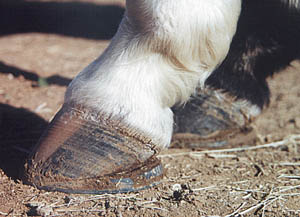
Doc's hooves right before his first natural trim, January 21, 2001
WE FIND DR. STRASSER
Meanwhile, I was spending as much time as I could on the internet learning about
Cushing’s. I joined an E-Group for people with horses with Cushing’s
Disease. Several times Dr. Strasser was mentioned and her trim for foundered
horses. Founder is a big concern for horses with Cushing’s.
Then in August of 2000, Tamera had an episode of laminitis. Poor Tamera, who
had never been lame a day in her life. Traditional methods were followed, foam
pads, bute and Isosxuprine. Finally, one day I took Mary Goldy’s advice
from the Equine Cushing’s group and joined the natural horse trim group.
Mary had said in one of her posts “I have two words for you, Strasser Trim”.
Then things started moving fast, I saw that Dr. Strasser was also “curing”
navicular horses. It was like an answer to a prayer. I ordered Dr. Strasser’s
books from “The Horse’s Hoof” and for the next couple of months,
David and I spent all our free time reading. We were so excited and scared at
the same time. We also ordered Jaime Jackson’s books and poured over those
as well. Finally, I got in contact with Yvonne Welz and after several communications
with her, we decided to have her husband, James, come out and trim Tamera. We
wanted to see how Tamera fared with the trim and she was already out 24/7, plus
she had been barefoot for almost 2 years. James was one of Dr. Strasser’s
hoof care specialist students and we felt fortunate to have someone with experience
to guide us through this venture.
Tamera was trimmed Dec. 31, 2000. I was surprised, her stride, which for the
last few years had been short and choppy, lengthened. I had attributed her short
stride to arthritis. Tamera did well and appeared much more comfortable. We
were pleased. We still hesitated with Doc, would it be too drastic a change
for him to go barefoot and on top of that, the trim? What about his tendons
and ligaments? The angle change would be so dramatic, how much pain would he
have to endure? It took us three weeks to finally decide.
Doc received his first Strasser Trim on Jan. 21, 2001. We pulled his eggbars and pads and James trimmed his left foot first, then told us we would have to hurry and do his right one, as the feeling would start to return to his trimmed foot. Boy, was he right! We were about 2 or 3 minutes into the right foot when Doc started fidgeting and trying to pull away his right foot. Every time James would let him have his foot back, Doc would stretch his left leg forward and put it down, and lift it again. It was obvious he was feeling things he hadn’t felt for a long time. I had never seen him fidget so much. James patiently trimmed his back feet, giving him frequent rests.
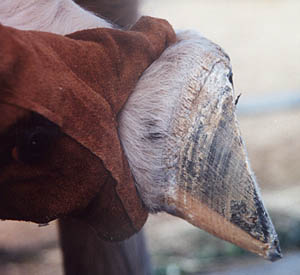
Doc's left front hoof right after his first natural trim on January 21, 2001
Once he was done, Doc walked off to the back pasture with no sign of lameness.
He had been somewhat gimpy before we pulled his shoes. We noticed his stride
was already longer. James warned us to expect abscessing. We had bought apple
cider vinegar and Davis soaking boots. We were ready.
The first 4 days Doc was tender and sore but he was a “trooper” and kept moving, slow, but stayed on his feet. He did lie down once or twice during the day, but not for more than 1/2 hour. I kept a close eye on him. Then, the 4th day he came trotting up from the back pasture. I breathed a sigh of relief, we had done the right thing. Since then Doc’s progress has been almost miraculous. Three weeks after the first trim, David rode him—he did great, not a sign of discomfort.
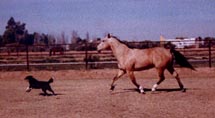
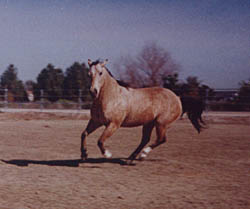
Doc just 3 weeks after the first trim.
Today, Doc runs and plays with no sign of lameness. He still has not abscessed. David is taking “Cowboy Dressage” lessons on him, he takes him out around the neighborhood, on the asphalt road. Doc continues to improve, we still marvel when he effortlessly, crosses over his front feet. Leg yielding in dressage is not a problem.
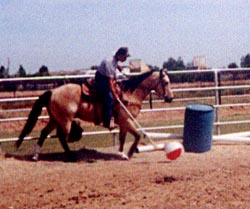
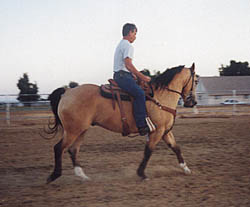
Left, Doc playing Broomstick Polo in April 2001. Right, Doc practicing Cowboy
Dressage in May 2001.
We have made some changes to our stall area, to accommodate the “Strasser”
lifestyle. All our horses are free to come and go as they please. We have no
doubt in our minds that we have done right by Doc, and Tamera too. I guess Tamera’s
Cushing’s was a blessing in disguise, for I would have never discovered
Dr. Strasser if it hadn’t been for that e-group. Life is funny, isn’t
it? You just never know.
02/20/02 Update
Claire: "The reason that I am so commited to this
method is because I have personally seen it work. Our very own precious gelding,
Doc has a new lease on life because of this method. He has not exhibited any
signs of lameness or pain since we started this method in January of 2001. We
are able to ride him any time we want and his stride has lengthened, he can
be worked and ridden in small circles to either side without any discomfort
whatsoever. I still marvel when I watch him cross over his front feet. His hooves
are still changing shape, they have lost that boat-like appearance, so common
in navicular horses and have become rounder and wider. Anyone who doubts my
claims is more than welcome to come and see Doc for themselves.
"I am being honest when I say that this method is not for everyone, because it takes alot of commitment and study on the part of the owner. Some owners cannot and are not willing to do this for numerous reasons. But for those owners who are willing to go the very long extra mile for the love of their horses, I beg of you, look into this method. If you had only seen Doc limp up from the pasture (with his eggbar shoes and pads) the day we removed his shoes and started this method and then after his first trim, walk back out without a limp. And now watch him under saddle or playing in the pasture, you would be amazed. As always, I'm available and willing to answer any questions in regards to Doc's recovery, if it'll help another navicular horse. Horses don't have to be put down because of navicular syndrome. At the risk of sounding simplistic, all you have to do is remove the cause, which is heel contraction, be it from incorrect trimming or shoeing. It's just that it so hard for me to hear of horses being put down because of navicular, when I can look out my window and see the living proof that this condition can be turned around." Claire Wilson
02/21/03 Update
"Doc - he is wonderful, full of life and playfulness. He is a joy to ride,
always ready to run but seems to control himself with me unless I ask him. I
love to make him spin because he does it so effortlessly, he could never cross
those front legs over the way he does now.....He also has a nice working trot
he would never offer before." Claire Wilson
For more photos of Doc's hooves, please visit: Doc's Case Study by James Welz
Note: Photos are provided for reference and educational purposes only, and are not meant to indicate guidelines for trimming. Every horse should be trimmed as an individual. Opinions vary as to what constitutes "correct" but keep in mind - there are NO PERFECT FEET, not even in the wild. Owners are cautioned to seek professional help for the trimming of their own horse's feet. Owner trimming of pathological feet is not advised. Photos may not be reproduced, copied, or distributed in any way.
©2006 by The Horse's Hoof. All rights reserved. No part of these publications may be reproduced by any means whatsoever without the written permission of the publisher and/or authors. The information contained within these articles is intended for educational purposes only, and not for diagnosing or medicinally prescribing in any way. Readers are cautioned to seek expert advice from a qualified health professional before pursuing any form of treatment on their animals. Opinions expressed herein are those of the authors and do not necessarily reflect those of the publisher.
The Horse's Hoof Website
Home - About Us -
Articles - Barefoot Performance - Barefoot
Stories - Hoof Gallery
- Natural
Horse Care - EPSM
- Events - Trimmers
- Experts - Friends
- Classified - Resources
- News - Links
- Strasser
Hoofcare Links
To go shopping or subscribe to our magazine, please click here: The
Horse's Hoof Store
If you don't see a column to the left: To view the frames version of this site, please click here: TheHorsesHoof.com
The Horse's Hoof is a division of:
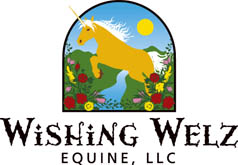
The Horse's Hoof
P.O. Box 1969
Queen Creek, AZ 85142
Phone (623) 935-1823
Message Phone: 1-623-935-1823
(Leave a message anytime.)
Email: editor @ TheHorsesHoof.com (delete spaces)